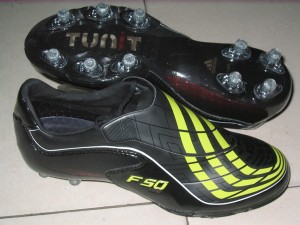Difference Between Soft Ground and Firm Ground
Table of Contents
Soft Ground vs Firm Ground
Difference between soft ground and firm ground does not mean that this article is about different types of grounds as one may believe after reading the title of the article. Soft ground (SG) and firm ground (FG) are, actually, types of cleats or footwear that soccer players need to wear depending upon ground conditions. Anyone who plays soccer is aware of how important it is to wear the right kind of shoes in a soccer match as a lot depends upon them. Even a very good player may give a mediocre performance if he is not wearing the kind of shoes that ground conditions require. This article will talk about the differences between soft ground and firm ground cleats that have become household names for soccer players.
Shoes worn while playing soccer are called soccer cleats. The main purpose of wearing them is to allow a player to have sufficient traction so that he does not slip. These cleats help a player to run, stop, and accelerate with ease and quickly. The manner in which cleat manufacturers seek to achieve this is to make the outsole with rubber, metal, and plastic studs that are designed to sink in the field providing a good grip to the players. The studs need to be long enough so as to provide traction and, at the same time, short enoughso not to cause any discomfort to the players by applying high pressure on the feet. Apart from this, cleats are made variously because ground conditions may vary greatly. Some grounds are soft while others are hard. Some have firm grounds while ground conditions may change even after rains.
What are Soft Ground Cleats?
Soft ground (SG) cleats are suitable for playing soccer on soft fields. SG cleats are characterized by detachable studs or tips of studs. These studs are either circular or have a blade like shape. A player can adjust according to the playing conditions on the ground as these studs are of varying lengths. So when a player gets a firm ground, he can adjust to the shortest possible stud. When it comes to the placing of studs, most models of SG cleats have four studs under the ball of the foot. Then, two to four studs are under the heel of the foot. One must remember that, if the ground is too hard for the studs to dig into, the player will lose his balance. That can lead him to injuries such as rolled ankle.

What are Firm Ground Cleats?
On the other hand, firm ground (FG) cleats are the most popular around the world. They are ideal for most firm natural surfaces. For example, a well-maintained grass field. A vast majority of soccer games for youth are played on grounds that are neither too hard nor too soft and which is why FG cleats are so popular in the US. FG cleats are adjustable in the sense that they can do very well in case of soft ground conditions too. It is a fact that it is difficult for an average player to have two or more pairs of cleats. This is the reason players choose to buy FG cleats, which help them play well on different ground conditions. When it comes to stud placing, FG cleats have about 10 to 14 studs across the soleplate that help traction and pivoting.

What is the difference between Soft Ground and Firm Ground Cleats?
• Cleats are classified as Soft Ground (SG) and Firm Ground (FG) depending upon whether a player is playing on a firm ground or soft ground.
• FG cleats are considered universal as they are adaptable to all soccer fields and are typically suited on a well-maintained grass field.
• SG cleats are, however, preferred when playing on a soft ground. These cleats are perfect when muddy conditions prevail in the ground.
• Most models of SG cleats have four studs under the ball of the foot. Then, two to four studs are under the heel of the foot. A FG cleat has about 10 to 14 studs across the soleplate that help traction and pivoting.
Images Courtesy:
ncG1vNJzZmivp6x7pbXFn5yrnZ6YsqOx07CcnqZemLyue8OinZ%2Bdopq7pLGMm5ytr5Wau26%2Fzp%2BrZp%2BipMKvsIyapZ1lpqh6p7XRpmSgqp%2Bqu6V7